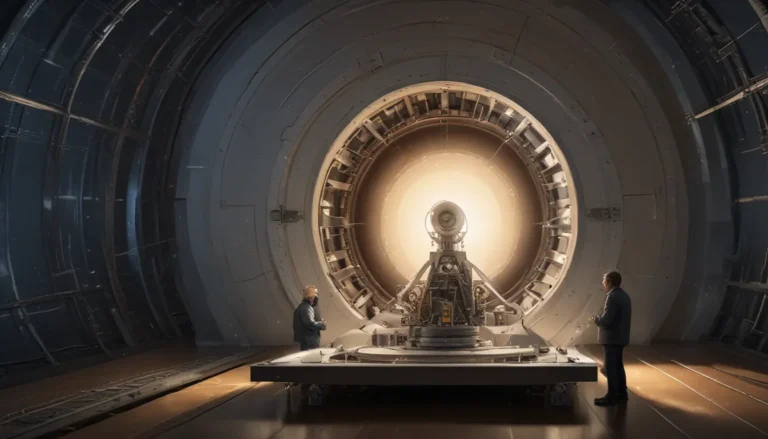A Note About Images: The images used in our articles are for illustration purposes only and may not exactly match the content. They are meant to engage readers, but the text should be relied upon for accurate information.
Are you ready to embark on an exciting journey into the realm of physics? One of the most captivating laws that governs the behavior of gases is Charles’s Law. Named after the esteemed French physicist Jacques Charles, this law delves into the intriguing relationship between the temperature and volume of a gas when pressure is held constant. In this article, we will uncover 19 captivating facts about Charles’s Law, shedding light on its origins, applications, and implications in the world of physics. Whether you are a science enthusiast, a student studying physics, or simply curious about the laws that govern our universe, these facts will provide you with a deeper understanding and appreciation of Charles’s Law.
Understanding the Foundation of Charles’s Law
Key Takeaways:
– Charles’s Law explains how gases behave when they get hotter or colder, serving as a rulebook for gas behavior.
– By grasping Charles’s Law, we can predict gas reactions in various scenarios, from airbag inflation to food preservation, granting us control over gases like a superpower.
The Origins of Charles’s Law
-
Historical Context: Jacques Charles, also known as Charles de Villette, was a French scientist who initially described the relationship between temperature and volume in the late 18th century.
-
Fundamental Principle: Charles’s Law is a cornerstone of thermodynamics, a critical aspect in the study of gases and their behavior.
The Mechanics of Charles’s Law
-
Basic Equation: The equation for Charles’s Law is expressed as V1/T1 = V2/T2, representing the initial and final states of the gas, where V1 and T1 denote the initial volume and temperature, and V2 and T2 denote the final volume and temperature.
-
Ideal Gas Behavior: While gases in reality may not perfectly adhere to Charles’s Law, it presents a valuable approximation for ideal gases under normal conditions.
Application and Implications of Charles’s Law
-
Real-World Utilization: Understanding the relationship between temperature and volume is essential in various industries like automotive, where it aids in engine design and operation.
-
Visual Representation: By heating up a balloon, one can witness Charles’s Law in action as the air inside expands, showcasing the principles of gas behavior.
Unveiling the Practical Applications of Charles’s Law
Integration of Charles’s Law in Diverse Fields
-
Aerospace Industry: The application of Charles’s Law in rocket propulsion highlights its significance in aerospace engineering.
-
Chemical Processes: In chemistry, Charles’s Law plays a vital role in understanding how temperature affects the volume of gases during reactions.
Food Industry:** The preservation of food relies on the principles of Charles’s Law, emphasizing its role in maintaining food quality and safety.
Exploring the Versatility of Charles’s Law
-
Safety Measures in Scuba Diving: Understanding the changes in pressure and volume with temperature is crucial for ensuring the safety and functionality of scuba diving equipment.
-
Airbag Deployment: Charles’s Law is integral in predicting how airbags inflate and safeguard passengers during collisions, showcasing its practical implications in automotive safety.
Unraveling the Essence of Charles’s Law
Delving Deeper into Charles’s Law
-
Temperature Scale: Charles’s Law can be expressed in both Kelvin and Celsius, with the Kelvin scale often preferred for scientific calculations.
-
Scientific Foundation: Charles’s Law stems from the kinetic theory of gases, which explains gas behavior in terms of molecular motion and interactions.
Fundamental Connections with Other Gas Laws
-
Complementing Boyle’s Law: The relationship between pressure and volume in Boyle’s Law, when combined with Charles’s Law, contributes to the ideal gas law.
-
Direct Impact: The succinct phrase “As temperature increases, so does the volume” encapsulates the essence of Charles’s Law and its influence on gas behavior.
Embracing the Impact of Charles’s Law in Everyday Life
Extending the Reach of Charles’s Law
-
Calculation of Absolute Zero: By extrapolating the volume-temperature relationship, scientists can determine absolute zero, representing the theoretical point at which gas particles cease movement.
-
Diverse Industry Applications: The utilization of Charles’s Law extends to aerospace, chemistry, and food processing, driving innovations in rocket propulsion, chemical reactions, and food preservation.
Conclusion: Embracing the Marvels of Charles’s Law
In conclusion, Charles’s Law stands as a compelling concept within the realm of physics, shedding light on the intricate relationship between temperature and volume. By comprehending and applying this law, scientists have made significant strides in various industries, shaping advancements in thermodynamics and enhancing our daily lives. As we traverse the realm of physics, laws like Charles’s Law serve as guiding beacons, illuminating the pathways to new discoveries and innovations that enrich our understanding of the universe.
FAQs on Charles’s Law
Frequently Asked Questions
- What is Charles’s Law?
-
Charles’s Law is a gas law that defines the relationship between temperature and volume at a constant pressure.
-
Who discovered Charles’s Law?
-
French physicist Jacques Charles was the visionary behind the discovery of Charles’s Law in the late 18th century.
-
How does Charles’s Law benefit everyday life?
-
Charles’s Law finds applications in various scenarios, from air conditioning systems to weather phenomena, offering insights into the behavior of gases.
-
What happens to the volume of a gas when its temperature increases?
-
According to Charles’s Law, if the temperature of a gas rises, its volume also increases proportionally, provided the pressure remains constant.
-
Can Charles’s Law be applied universally to all gases?
- Charles’s Law serves as a broad gas law applicable to all gases, maintaining its validity as long as pressure remains constant.
Embark on a fascinating exploration of Charles’s Law, uncovering a multitude of mind-boggling details and revelations that will expand your knowledge of gas laws. Prepare to be captivated by the wonders of physics as you delve into the intriguing world of Charles’s Law and its profound implications. Join us on this enlightening journey of discovery and scientific exploration as we unravel the secrets of the universe through the lens of Charles’s Law.






